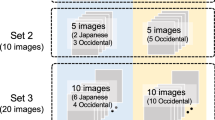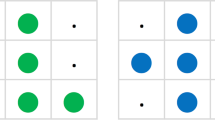Abstract
Humans have the unique ability to create art, but non-human animals may be able to discriminate “good” art from “bad” art. In this study, I investigated whether pigeons could be trained to discriminate between paintings that had been judged by humans as either “bad” or “good”. To do this, adult human observers first classified several children’s paintings as either “good” (beautiful) or “bad” (ugly). Using operant conditioning procedures, pigeons were then reinforced for pecking at “good” paintings. After the pigeons learned the discrimination task, they were presented with novel pictures of both “good” and “bad” children’s paintings to test whether they had successfully learned to discriminate between these two stimulus categories. The results showed that pigeons could discriminate novel “good” and “bad” paintings. Then, to determine which cues the subjects used for the discrimination, I conducted tests of the stimuli when the paintings were of reduced size or grayscale. In addition, I tested their ability to discriminate when the painting stimuli were mosaic and partial occluded. The pigeons maintained discrimination performance when the paintings were reduced in size. However, discrimination performance decreased when stimuli were presented as grayscale images or when a mosaic effect was applied to the original stimuli in order to disrupt spatial frequency. Thus, the pigeons used both color and pattern cues for their discrimination. The partial occlusion did not disrupt the discriminative behavior suggesting that the pigeons did not attend to particular parts, namely upper, lower, left or right half, of the paintings. These results suggest that the pigeons are capable of learning the concept of a stimulus class that humans name “good” pictures. The second experiment showed that pigeons learned to discriminate watercolor paintings from pastel paintings. The subjects showed generalization to novel paintings. Then, as the first experiment, size reduction test, grayscale test, mosaic processing test and partial occlusion test were carried out. The results suggest that the pigeons used both color and pattern cues for the discrimination and show that non-human animals, such as pigeons, can be trained to discriminate abstract visual stimuli, such as pictures and may also have the ability to learn the concept of “beauty” as defined by humans.





Similar content being viewed by others
References
Anderson JR, Kuwaharam H, Kuroshimma H, Leighty KA, Fujita K (2005) Are monkeys aesthetists? Rensch (1957) revisited. J Exp Psychol: animal Behav Proc 31:71–78
Aust U, Huber L (2001) The role of item- and category specific information in the discrimination of people versus nonpeople images by pigeons. Anim Learn Behav 29:107–119
Berlyne DE (1969) The reward value of indifferent stimulation In Tapp, J.K (ed) Reinforcement and Behavior, 179-214. Academic Press (New York)
Berlyne DE (1976) Aesthetics and psychobiology. Appleton, Century-Crofts (New York)
Butler RA (1953) Discrimination by rhesus monkeys to visual exploration motivation. J Comp Physiol Psychol 50:177–179
Cellera J (1980) The pigeon’s analysis of picture. Pattern Recognit 12:1–6
Cook RG (1992) The visual perception and processing of texture by pigeons. In: Honig WK, Fetterman JG (eds) Cognitive aspects of stimulus control. LEA, New Jersey, pp 279–299
Covato KK, Cook RG (2001) Cognitive precedence for local information in hierarchical stimulus processing by pigeons. J Exp Psychol Anim Behav Proc 27:3–16
Draganiou TI, Nagle L, Kreutzer M (2002) Directional female preference for an exaggerated male trait in canary (Serinus canaria) song. Proc Roy Soc Lond B 269:2525–2531
Fechner von GT (1876) Vorschule der Aesthetik Breitkopf & Hartel (Leipzig)
Gibson BM, Lazarbera LF, Gosslin F, Schyns PG, Wasserman EA (2007) Non-accidental properties underlie shape recognition in mammalian and non-mammalian vision. Curr Biol 17:336–340
Goto K, Lea SEG (2003) Discrimination of direction of movements in pigeons following previous experience of motion/static discrimination. J Exp Anal Behav 80:29–42
Herrnstein RJ, Loveland DH (1964) Complex visual concept in the pigeon. Science 146:549–551
Herrnstein RJ, WJr Vaughan, Mumford DB, Kosslyn SM (1989) Teaching pigeons on abstract rule: Insideness. Percept Psychophys 46:56–64
Hollard VD, Delius JD (1982) Rotational invariance in visual pattern recognition by pigeons and humans. Science 218:804–806
Lea SEG, Goto K, Osthaus B, Ryan ME (2006) The logic of the stimulus. Anim Cogn 9:247–256
Lewis-Williams D (2002) The mind in the cave: consciousness and the origin of arts. Thames & Hudson, London
McDermott J, Hauser MD (2007) Nonhuman primates prefer slow tempos but dislike music overall. Cognition 104:654–668
Mpodozis J, Letelier JC, Concha ML, Maturana H (1995) Conduction velocity group in the retino-tectal and retino-thamamic visual pathways of the pigeon (Columba livia). Int J Neurosci 81:123–136
Rensch B (1957) Asthetische Faktoren bei Farb- und Formbevorzugungen von Affen. Z Tierpsychol 14:71–99
Solso RL (2003) The psychology of art and the evolution of the conscious brain. MIT Press, Cambridge
Uy JAC, Patricell GL, Borga G (2001) Complex mate searching in the satin bowerbird Pitlonorhynchus violence. Am Nat 158:530–542
Voland E, Grammer K (eds) (2003) Evolutionary aesthetics. Springer, Berlin
Wasserman EA, Kiedinger RE, Bhatt RS (1988) Conceptual behavior in pigeons: categories, subcategories, and pseudocategories. J Exp Psychol Anim Behav Proc 14:235–246
Watanabe S (1988) Failure of visual prototype learning in the pigeon. Anim Learn Behav 16:147–152
Watanabe S (1991) Effects of ectostriatal lesions on natural concept, pseudo concept and artificial pattern discrimination in pigeons. Vis Neurosci 6:497–506
Watanabe S (2001a) Discrimination of cartoon and photographs in pigeons: effects of scrambling of elements. Behav Proc 53:3–9
Watanabe S (2001b) Van Gogh, Chagall and pigeons. Anim Cog 4:147–151
Watanabe S, Nemoto M (1998) Reinforcing property of music in Java sparrows (Padda oryzivora). Behav Proc 43:211–218
Watanabe S, Wakita M, Sakamoto J (1995) Discrimination of Monet and Picasso in pigeons. J Exp Anal Behav 63:165–174
Zaidel DW (2006) Neuropsychology of art. Psychology Press, Hove
Zeki S (1999) Inner vision: an exploration of art and the brain. Oxford University Press, London
Zeller A (2007) “What’s in a picture?” A comparison of drawings by ape and children. Semiotica 166:181–214
Acknowledgment
The author wants to express his thanks to the elementary school of Keio for providing me with samples of children’s paintings and Dr. Tadd Patton for stylistic correction. This research was supported by the Program of Global COE (Center of excellence) #D029 in Japan.
Author information
Authors and Affiliations
Corresponding author
Electronic supplementary material
Below is the link to the electronic supplementary material.
Rights and permissions
About this article
Cite this article
Watanabe, S. Pigeons can discriminate “good” and “bad” paintings by children. Anim Cogn 13, 75–85 (2010). https://doi.org/10.1007/s10071-009-0246-8
Received:
Revised:
Accepted:
Published:
Issue Date:
DOI: https://doi.org/10.1007/s10071-009-0246-8




